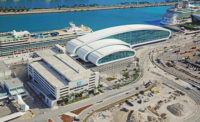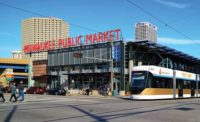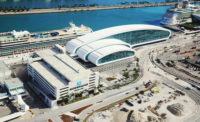Silver Line Gateway
Chelsea, Mass.
Best Project
Owner: Massachusetts Bay Transportation Authority (MBTA)
Lead Design Firm/Structural Engineer/Civil Engineer: AECOM Technical Services Inc.
General Contractor: McCourt Construction Co.
Structural Engineer: Green International Affiliates
Community Outreach: Regina Villa Associates
Construction of the Silver Line Busway along a confined corridor required close coordination with multiple stakeholders to avoid disrupting a nearby Massachusetts Bay Transportation Authority commuter rail line or adjacent buildings.
The $56.7-million project, which includes the new 1.3-mile-long exclusive busway and four dedicated bus rapid transit stations, produced the first dedicated bus rapid transit service introduced to the MBTA since 2007. The three-year project included transit signal priority at intersections. A new multi-use path, also incorporated within the overall right-of-way, connects two of the stations with abutting neighborhoods and a larger bicycle network.
The replacement of an obsolete roadway bridge with a newly designed one was required to provide sufficient width for the heavily traveled two-way busway beneath it. The revised bridge design includes longer spans and a center pier constructed adjacent to the railroad tracks.
The team’s coordination with local and MBTA officials as well as neighboring communities was impressive, the judges noted. For instance, the team closely coordinated with MassDOT and the city of Chelsea on developing a design and staging plan for the bridge replacement that maintained vital emergency access and rail operations.
In terms of complexity, the Silver Line project was competently executed, another judge said, noting, “The benefit overall to those communities is quite substantial.”
Due to construction constraints, the team designed and constructed numerous retaining walls. Three were more than 24 ft high and one was located only 15 ft from the corner of an old stone church. Soldier pile and lagging wall strategies were developed to ensure minimal impact to the adjacent buildings, the team says, noting that retaining walls were composed of 42-in.-dia shafts up to 45 ft deep. As part of the excavation, large galvanized steel piles and timber lagging were installed, and precast concrete panels were inserted between the webs of the steel piles. A drainage system was installed behind the walls with backfill including crushed stone and lightweight fill. Throughout construction, the team monitored adjacent structures and found no movement of existing buildings.
Close coordination with utility company Eversource was required to relocate eight overhead transmission line poles that carry an Eversource 115-kV high-tension power line in conflict with the busway. Close coordination with Bell Canada was also required since major portions of the project were constructed over and near an underground fiber line, part of the transcontinental line connecting North American with Europe. To ensure uninterrupted service, the team performed numerous test pits, uncovered the line and encased it in concrete before excavation.







